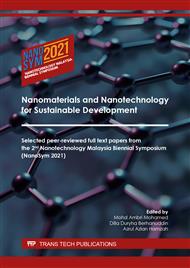[1]
Sim WC, Kutrakul N, Khunkaewla P, Schulte A., Three-electrode 30–60 μL mini-cell for ecologically conscious analytical voltammetry with common macro-and microelectrodes, ACS Sustainable Chemistry & Engineering. 8(13) (2020) 5082-5090.
DOI: 10.1021/acssuschemeng.9b07034
Google Scholar
[2]
Lanyon, Y.H. and D.W.M. Arrigan, Recessed nanoband electrodes fabricated by focused ion beam milling, Sensors and Actuators B: Chemical. 121(1) (2007) 341-347.
DOI: 10.1016/j.snb.2006.11.029
Google Scholar
[3]
Fletcher, S. and M.D. Horne, Random assemblies of microelectrodes (RAM™ electrodes) for electrochemical studies, Electrochemistry Communications. 1(10) (1999) 502-512.
DOI: 10.1016/s1388-2481(99)00100-9
Google Scholar
[4]
Stulík K, Amatore C, Holub K, Marecek V, Kutner W., Microelectrodes. Definitions, characterization, and applications (Technical report), Pure and Applied Chemistry. 72(8) (2000) 1483-1492.
DOI: 10.1351/pac200072081483
Google Scholar
[5]
Arrigan, D.W.M., Nanoelectrodes, nanoelectrode arrays and their applications, Analyst. 129(12) (2004) 1157-1165.
DOI: 10.1039/b415395m
Google Scholar
[6]
Huang, X.J., A.M. O'Mahony, and R.G. Compton, Microelectrode Arrays for Electrochemistry: Approaches to Fabrication, Small. 5(7) (2009) 776-788.
DOI: 10.1002/smll.200801593
Google Scholar
[7]
Bartlett, P.N. and S.L. Taylor, An accurate microdisc simulation model for recessed microdisc electrodes. Journal of Electroanalytical Chemistry. 453(1–2) (1998) 49-60.
DOI: 10.1016/s0022-0728(98)00242-3
Google Scholar
[8]
Beni, V. and D.W.M. Arrigan, Microelectrode arrays and microfabricated devices in electrochemical stripping analysis, Current Analytical Chemistry. 4(3) (2008) 229-241.
DOI: 10.2174/157341108784911406
Google Scholar
[9]
Godino N, Borrise X, Munoz FX, Del Campo FJ, Compton RG, Mass transport to nanoelectrode arrays and limitations of the diffusion domain approach: theory and experiment, The Journal of Physical Chemistry C. 113(25) (2009) 11119-11125.
DOI: 10.1021/jp9031354
Google Scholar
[10]
Vidal JC, Bonel L, Ezquerra A, Hernández S, Bertolín JR, Cubel C, Castillo JR, Electrochemical affinity biosensors for detection of mycotoxins: A review, Biosensors and Bioelectronics. 49 (2013) 146-158.
DOI: 10.1016/j.bios.2013.05.008
Google Scholar
[11]
https://www.allaboutfeed.net/specials/exploring-mycotoxins-across-the-continents/.
Google Scholar
[12]
Edwards S, Barrier-Guillot B, Clasen PE, Hietaniemi V, Pettersson H, Emerging issues of HT-2 and T-2 toxins in European cereal production, World Mycotoxin Journal. 2(2) (2009) 173-179.
DOI: 10.3920/wmj2008.1126
Google Scholar
[13]
Wannemacher RW, Wiener SL, Sidell FR, Takafuji ET, Franz DR, Trichothecene mycotoxins. Medical aspects of chemical and biological warfare. 6 (1997) 655-676.
Google Scholar
[14]
Makun HA, Dutton MF, Njobeh PB, Mwanza M, Kabiru AY. Natural multi-occurrence of mycotoxins in rice from Niger State, Nigeria, Mycotoxin research. 27 (2) (2011) 97-104.
DOI: 10.1007/s12550-010-0080-5
Google Scholar
[15]
Said NAM, Twomey K, Ogurtsov VI, Arrigan DW, Herzog G. Fabrication and electrochemical characterization of micro-and nanoelectrode arrays for sensor applications, Journal of Physics: Conference Series. (307) (2011) 012052.
DOI: 10.1088/1742-6596/307/1/012052
Google Scholar
[16]
Mohd Said, N.A. Electrochemical biosensor based on microfabricated electrode arrays for life sciences application. PhD Thesis University College Cork. (2014).
Google Scholar
[17]
Vashist, S.K., Comparison of 1-Ethyl-3-(3-Dimethylaminopropyl) Carbodiimide Based Strategies to Crosslink Antibodies on Amine-Functionalized Platforms for Immunodiagnostic Applications, Diagnostics. 2(3) (2012) 23-33.
DOI: 10.3390/diagnostics2030023
Google Scholar
[18]
Vashist, S.K., A highly-sensitive and rapid Surface Plasmon Resonance immunoassay procedure based on the covalent-orientated immobilization of antibodies, (2011).
DOI: 10.1038/protex.2011.259
Google Scholar
[19]
Bond, A.M., K.B. Oldham, and C.G. Zoski, Steady-state voltammetry, Analytica Chimica Acta, 216(0) (1989) 177-230.
DOI: 10.1016/s0003-2670(00)82009-7
Google Scholar
[20]
Nagale, M.P. and I. Fritsch, Individually Addressable, Submicrometer Band Electrode Arrays. 2. Electrochemical Characterization. Analytical Chemistry. 70(14) (1998) 2908-2913.
DOI: 10.1021/ac971041p
Google Scholar
[21]
Guerrette, J.P., S.J. Percival, and B. Zhang, Voltammetric Behavior of Gold Nanotrench Electrodes, Langmuir. 27 (19) (2011) 12218-12225.
DOI: 10.1021/la2023743
Google Scholar
[22]
Amatore C, Pebay C, Sella C, Thouin L, Mass transport at microband electrodes: transient, quasi‐steady‐state, and convective regimes, ChemPhysChem. 13(6) (2012) 1562-1568.
DOI: 10.1002/cphc.201100942
Google Scholar
[23]
Wehmeyer, K.R., M.R. Deakin, and R.M. Wightman, Electroanalytical properties of band electrodes of submicrometer width. Analytical Chemistry. 57(9) (1985) 1913-1916.
DOI: 10.1021/ac00286a026
Google Scholar
[24]
Kovach PM, Caudill WL, Peters DG, Wightman RM, Faradaic electrochemistry at microcylinder, band, and tubular band electrodes, Journal of electroanalytical chemistry and interfacial electrochemistry. 185(2) (1985) 285-295.
DOI: 10.1016/0368-1874(85)80136-2
Google Scholar
[25]
Deakin, M.R., R.M. Wightman, and C.A. Amatore, Electrochemical kinetics at microelectrodes: Part II. Cyclic voltammetry at band electrodes, Journal of Electroanalytical Chemistry and Interfacial Electrochemistry. 215(1–2) (1986) 49-61.
DOI: 10.1016/0022-0728(86)87004-8
Google Scholar
[26]
Lisdat, F. and D. Schäfer, The use of electrochemical impedance spectroscopy for biosensing. Analytical and bioanalytical chemistry. 391(5) (2008) 1555-1567.
DOI: 10.1007/s00216-008-1970-7
Google Scholar
[27]
Edwards S, Barrier-Guillot B, Clasen PE, Hietaniemi V, Pettersson H., Emerging issues of HT-2 and T-2 toxins in European cereal production, World Mycotoxin Journal. 2(2) (2009) 173-179.
DOI: 10.3920/wmj2008.1126
Google Scholar
[28]
Nabok AV, Tsargorodskaya A, Holloway A, Starodub NF, Gojster O, Registration of T-2 mycotoxin with total internal reflection ellipsometry and QCM impedance methods, Biosensors and Bioelectronics. 22(6) (2007) 885-890.
DOI: 10.1016/j.bios.2006.03.010
Google Scholar
[29]
Williamson ML, Atha DH, Reeder DJ, Sundaram PV, Anti-T2 monoclonal antibody immobilization on quartz fibers: stability and recognition of T2 mycotoxin, Analytical Letters. 22(4) (1989) 803-816.
DOI: 10.1080/00032718908051368
Google Scholar


